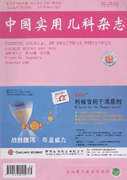:Objective To access the clinical efficacy and safety of high-pressure balloon dilatation of bronchial stenosis in children. Methods 5 cases of bronchial stenosis in children, including congenital stenosis, were managed by high-pressure balloon dilation using the flexible fiberopic brochoscope, the balloon was inflated for 1 to 3 min. Before the management and after the last balloon, the effectiveness were evaluated with chest X-ray and all of patients were followed-up 1-6 months. Results Patients required a 2-4 sessions balloon dilatation. After high-pressure balloon dilatations, the airway diameter was obviously increased and the clinical symptoms and signs were significant improvement. Chest X-ray manifestation of expanded sites was improved and pulmonary atelectasis and consolidation disappeared after follow-up periods of 1-6 months. The child with congenital stenosis had no recurrence of high-profile metal-like cough, pulmonary emphysema disappeared. Conclusion High-pressure balloon dilatation of is a safe, efficient, simple and rapid method for treatment of bronchial stenosis in children.

